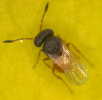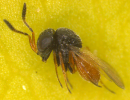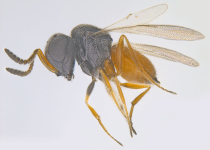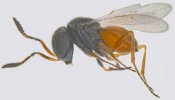 |
Scientific nameGryon fulviventre (Crawford) (=Hadronotus fulviventris, Gryon fulviventris)
Taxonomic positionHymenoptera: Platygastroidea: Platygastridae: Scelioninae
DiagnosisFemale: Length: 1mm. Head and thorax black, abdomen ferruginous, legs reddish testaceous, coxa and front femora on basal two-thirds black; scape testaceous, upper side medially
brownish; rest of antennae reddish brown, club darker brown; joints of funicle subquadrate; club 6-jointed, each subquadrate; face finely reticulated; mesoscutum finely rugulose, at rear medially becoming distinctly longitudinally so; scutellum longitudinally rugulose, at apex with a row of pits; metathorax with a row of pits and medially at apex with an elevated disk which is longitudinally rugulose; truncation of propodeum with rugulae diverging from center; mesopleurae with a row of pits at
front and one at rear, rest of the surface rugulose; metapleurae with a row of pits at front; marginal vein somewhat longer than pedicel of antennae; stigmal almost twice as long as marginal; postmarginal vein over twice as long as stigma. First abdominal segment with a row of pits at base, longitudinally striate, apical margin smooth; second segment with a row of pits at base, back of this with fine reticulations, almost resembling shallow thimble-like punctures; broad apical margin of second segment,
smooth; following segments with similar punctures and broad smooth apical margins.
Male: Similar to female, but with abdomen black; antenna brown, except scape; pedicel slightly longer than first joint of funicle, following joints subquadrate, apical joint almost as long as two preceding joints united; sculpture somewhat stronger than in female; middle and hind legs slightly suffused with brown toward base (description from Crawford, 1912). 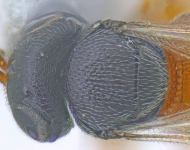
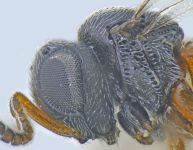 Head and thorax - dorsal and lateral view Head and thorax - dorsal and lateral view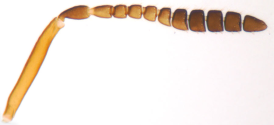
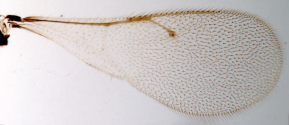 Female antenna and forewing venation Female antenna and forewing venation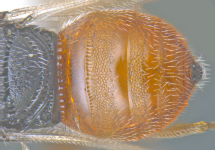 Gaster Gaster
ImagesDistributionWidely distributed in the Oriental and the Afrotropical regions. Commonly collected in India (Karnataka; Kerala; Tamil Nadu).
Hosts / BiologyOriginally described from the eggs of Clavigralla gibbosa on pigeon pea from Karnataka, India. Commonly collected as a parasitoid of the eggs of Heteroptera (Coreidae, Pentatomidae, etc.).
References
|

